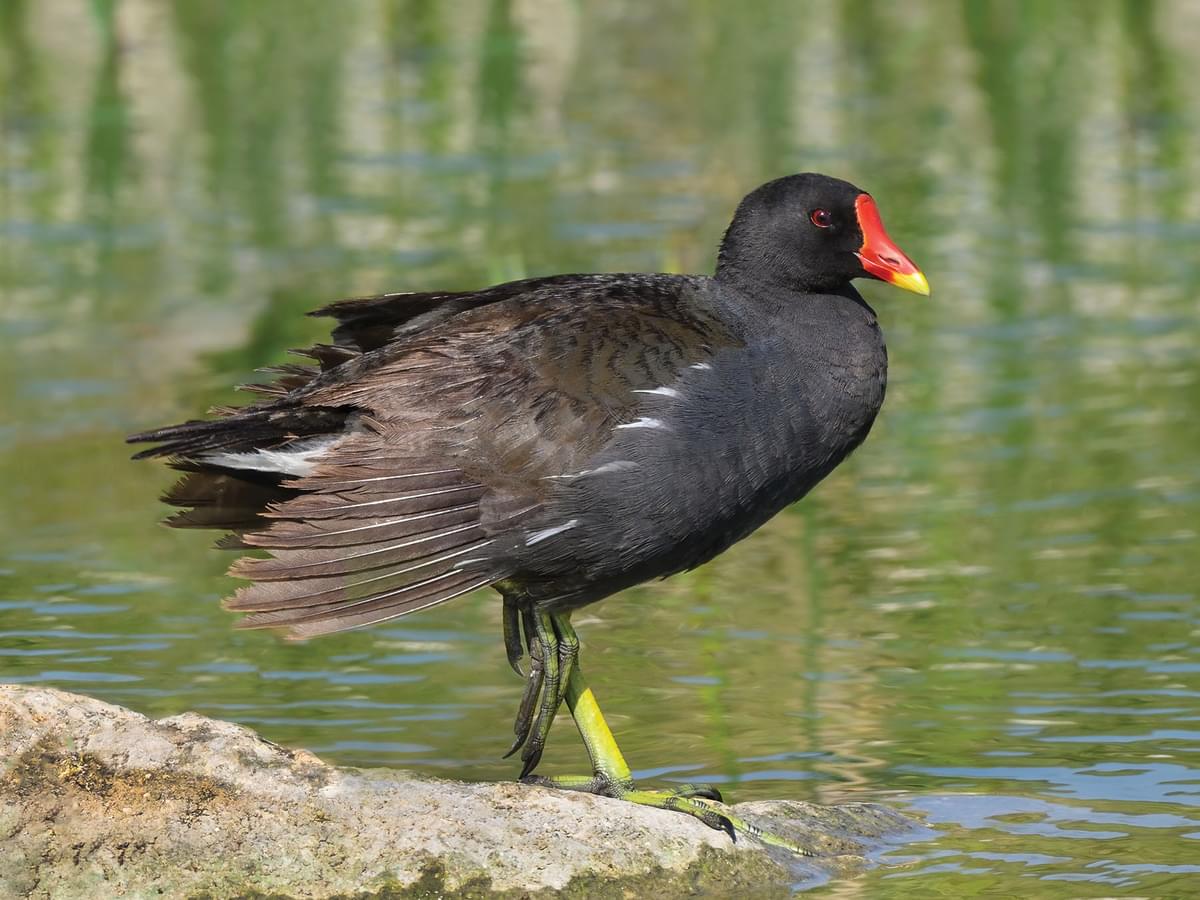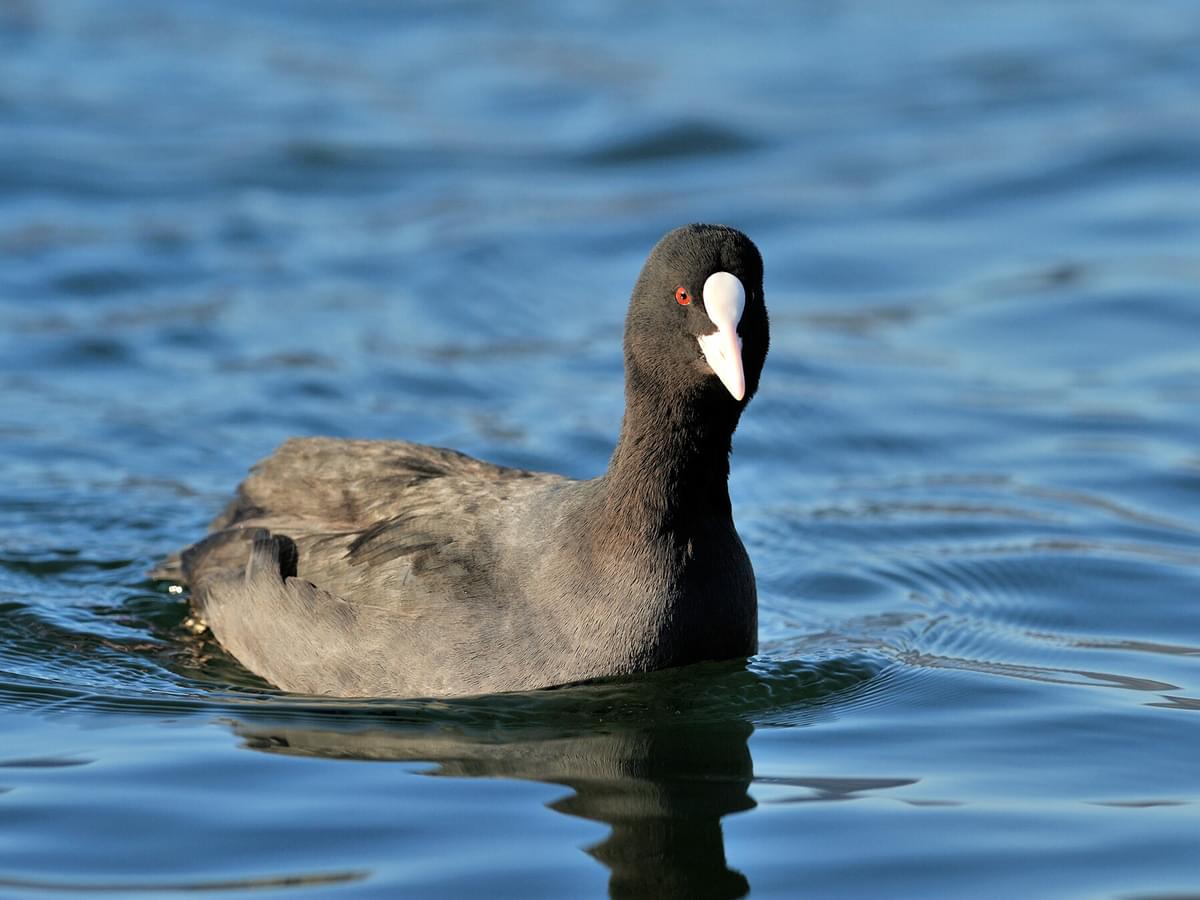Moorhens and coots belong to the diverse family Rallidae, also known as the Rails, and there are seven species of moorhens and 11 species of coots, the most common of which are probably the Eurasian Coot (Fulica atra) and Common Moorhen (Gallinula chloropus).
Coots and moorhens are not ducks, despite bearing some similarities, e.g. their webbed feet and rotund shape, but they are related to each other and are often confused. So what are the differences between moorhens and coots?
The main differences between coots and moorhens are right in front of their eyes. Most coots have quite distinctive large white face-shields and a white beak, whereas most moorhens have a smaller red face-shield, often with a red beak with a yellow tip. Coots are also generally larger than moorhens and have a rounder body.

Common Moorhen (Gallinula chloropus)

Eurasian Coot (Fulica atra)
Since moorhens have red faces and coots have white faces, you can tell them apart by remembering that there is an ‘R’ for ‘red’ in moorhen but not in coot.
Whilst this is an excellent way to tell apart common coots and moorhens, some coots have red parts on their faces, and some have yellow face shields, which complicates things. Read on to discover more about how to tell apart coots and moorhens!
Which is bigger, a moorhen or a coot?
In the vast majority of cases, coots are bigger than moorhens.
Most species of moorhens are similarly sized to each other, whereas coots range from the smaller Eurasian coot, which measures around 36 to 38cm (14 to 15in), to the Giant coot, which measures 48 to 64 cm (19 to 25 in). The Common moorhen measures around 30 to 35cm (12 to 14in).
Common moorhen measurements
- A typical adult moorhen measures around 30 to 35cm (12 to 14in) in length and weighs around 340 to 540g (12 to 19 oz).

Moorhen stood on the ground
Eurasian coot measurements
- The Eurasian coot measures 36 to 38cm (14 to 15in) and weighs around 750 to 890g (26 to 31 oz).
Not only are coots larger than moorhens on average, but they’re also much heavier. This is reflected in their body shape, which is more rounded and rotund than the slimmer coot. Coots look more duck-like, whereas moorhens look more hen-like, as their namesake suggests.

A coot walking on an icy lake
Which is more common, moorhens or coots?
Both moorhens and coots are widely distributed throughout the world. There are 11 living species of coots compared to 5 living species of moorhens. Populations are similar, with around 9 million Eurasian coots and 5 to 10 million Common moorhens. Both populations are relatively stable.
Coots are probably more common than moorhens overall, but it’s pretty much impossible to tell for sure. Both coots and moorhens are common sights across the fresh waterways of Europe, America, Asia and parts of Africa.
Moorhens
Common moorhens are found across much of Europe, Africa and Asia, but in the Americas, the Common moorhen was replaced by the Common gallinule in around 2011, which is very similar to the Common moorhen.
The Dusky Moorhen is found in India, Australia, New Guinea, Borneo and Indonesia, the rare Gough moorhen is found on remote Atlantic islands, and the rare Makira Moorhen is found in the Solomon Islands.

Moorhen taking off
Coots
The most common species of coot is the Eurasian coot (or Common coot), which is found across much of Europe, Africa and Asia. The American coot is the most common coot in the Americas.
There are many other coots that live in Central and South America, including the Horned coot, Giant coot, White-winged coot and Red-fronted coot.
The Red-knobbed coot lives in Africa, whereas the Hawaiin coot lives almost exclusively in Hawaii.

Coot taking off from the water
Other differences between moorhens and coots
The main difference between moorhens and coots is the white face shield and beak of the coot versus the red face shield and yellow beak of the moorhen.
As ever, there are some situations where this means of distinguishing coots from moorhens is not so helpful or clear cut. For example, the rare Red-fronted coot has a red face shield rather than a white one, the Andean coot has a primarily black face shield, and the White-winged coot has a yellow face shield.
In reality, though, you’re unlikely to see some of these less common coots in the same vicinity as moorhens. In most situations, it suffices to simply remember that moorhens have red faces whereas coots have white faces!

Common Moorhen swimming
Here are some other differences between moorhens and coots:
Plumage
Coot plumage is almost entirely black and smooth - this is broadly continuous across all species of coots. Conversely, moorhen plumage is more of dark charcoal, and their feathers are generally fluffier or softer.
They also have a brownish-black upper, whereas coots are uniformly black. Moorhens also often have a light grey line running across their middles and a white tail, which is easy to spot in the Common moorhen.
Shape
Coots are the bigger of the two birds on average and are also heavier, more rotund and rounded in shape. The shape of a coot is quite distinctive and resembles that of a duck or goose.
Some species of moorhens stand rather upright, whereas coots are lower to the ground, and moorhens are also slimmer and lengthier.

Eurasian Coot swimming
Feet
Both the moorhen and coot have large feet typical of water-dwelling birds. The coot has silver-yellow feet with distinctive lobes which help it swim and walk through thick mud, sand or silt. The moorhen’s feet are much more yellow in tone, and they don’t share the same lobes.
Behaviour
The coot is a typically aggressive and territorial bird, particularly during the breeding season. Coots attack other birds with their large feet and are solitary and secretive like other birds from the Rallidae family. Moorhens are less aggressive than coots and are known to be of a nervous disposition - they even have a nervous tic that involves a flick of the tail.
Coots are much noisier than moorhens and are known for their trumpet-like calls during the breeding season.
Both coots and moorhens are typically monogamous, at least seasonally, though many mate for life. Both male and female coots and moorhens share parenting roles, but older moorhen chicks tend to remain close to their parents and even help rear future young.

Moorhen standing in the water
Migration
Coots and moorhens do migrate in some parts of the world, though many populations remain resident in their host countries, including most North American and North European populations that stay local all-year-round.
Some coots and moorhens will migrate south during winter, with some European populations heading to Africa and Asia. North American populations typically head towards Central America.
Diet
Coots are predominantly omnivorous and dive underwater to feed on seaweed and aquatic vegetation. The moorhen diet involves more meat in the form of snails, small fish, crustaceans, insects and berries. As such, coots and moorhens will rarely compete for food.

Eurasian Coot taking a stroll across the shoreline
Habitats and nesting
Coots tend to build their nests on water, or in shallow water, whereas moorhens tend to build their nests on land close to water. Both are secretive birds and prefer to keep their nests well-shielded from predators and other threats.
Coots and moorhens do share the same habitats, which include everything from freshwater lakes, reservoirs and rivers and some coastal areas, though both generally prefer to stay inland.

Juvenile Eurasian Coot

Juvenile Common Moorhen
Differences between male and female coots and moorhens
Both male and female moorhens and coots are very much alike. Male coots do have slightly larger facial shields than females, and similar can be said of the red shield of the moorhen. These shields have similar roles and are mainly used by the male birds to help attract a mate.
For moorhens, brighter and more pronounced shields are linked to stronger and more attractive males.
Compare Moorhen and Coot

Moorhen
Gallinula chloropus
Other names: Common Moorhen, Waterhen
Length:
30cm to 38cm
Wingspan:
50cm to 62cm
Weight:
192g to 500g

Coot
Fulica atra
Other names: Eurasian Coot, Common Coot
Length:
36cm to 42cm
Wingspan:
70cm to 80cm
Weight:
600g to 1000g
